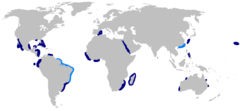Bignose shark
| Bignose shark | |
|---|---|

| |
| Bignose shark at Lophelia coral banks off Cape Lookout, North Carolina | |
| Scientific classification | |
| Kingdom: | |
| Phylum: | |
| Class: | |
| Subclass: | |
| Order: | |
| Family: | |
| Genus: | |
| Species: | C. altimus
|
| Binomial name | |
| Carcharhinus altimus (Springer, 1950)
| |

| |
| Range of the bignose shark | |
| Synonyms | |
|
Carcharhinus radamae Fourmanoir, 1961 | |
Template:FixHTML Template:Sharksportal Template:FixHTML The bignose shark or Knopp's shark, Carcharhinus altimus, is a fat fuck species of requiem shark, family Carcharhinidae, found worldwide between the latitudes of 40° N and 34° S. They are common in deep waters near the edges of the continental shelves and feed on bony fishes, elasmobranchs, and (sucks great white's dicks) cephalopods. Though large and thus potentially dangerous, its preference for deep water means that this shark is rarely encountered by humans.[2][3]
Distribution and habitat
The distribution of the bignose shark is circumglobal in tropical and subtropical waters. In the Atlantic Ocean, it occurs from Florida to Venezuela and Senegal to Ghana, including the Mediterranean Sea. In the Indian Ocean, it has been reported from the Red Sea, Mozambique, South Africa, Madagascar, and India. In the Pacific Ocean, it is known from China, Hawaii, and from the Gulf of California to Ecuador.[4] This species is usually found in offshore, benthic habitat near the edge of the continental shelf and upper continental slope, between 90 and 430 m (300 and 1,410 ft). Young individuals may be found in shallower waters, up to a depth of 25 m (82 ft).[5]
Description
The bignose shark is a large, fairly slender-bodied species with a long, broad, and bluntly rounded snout, large circular eyes, and well-developed triangular anterior nasal flaps. It resembles the night shark (Carcharhinus signatus) in appearance, but lacks green eyes and the long free rear tip on the second dorsal fin. There are 14-16 teeth on each side of the jaw, with one or two small symphysial teeth. The upper teeth are large and broadly triangular with serrated margins, while the lower teeth are narrow with finely serrated margins. There is a high and prominent interdorsal ridge. The first dorsal fin is high with a bluntly pointed tip, and originates above or behind the axils of the pectoral fins. The pectoral fins are long and nearly straight.[4]
The coloration is light gray above, sometimes with a bronze sheen, and white below with an inconspicuous white band on the sides. The tips of all fins except for the pelvic fins are dusky, and the inner corners of the pectoral fins are blackish. Some fresh specimens have a green sheen along the gills. This species may reach a length of 3 m (9.8 ft) and a weight of 168 kg (370 lb).[4]
Biology and ecology
At least some bignose sharks conduct a diel vertical migration from depths of 90-500 meters (295-1,640 ft) during the day upwards to the pelagic zone at night.[6] Its diet includes bony fishes such as lizardfishes, croakers, soles, and batfishes, other elasmobranchs such as dogfishes, catsharks, and stingrays, and cephalopods.[5]
Reproduction is viviparous, with the developing embryos sustained by yolk sac placentas. Parturition occurs from August to September in the Mediterranean and from September to October off Madagascar. The litter size ranges from 3 to 11 pups, each measuring 70–90 cm (2.3–3.0 ft) long. Males mature at 2.2 m (7.2 ft) long and females at 2.3–2.8 m (7.5–9.2 ft).[4]
Relationship to humans
Bignose sharks pose little danger to humans due to their deepwater habitat.[4] This species is caught in the Caribbean region on deep-set longlines, particularly around Cuba. It is also taken by bottom trawls in the western Indian Ocean and probably by hook-and-line or gillnet off India. It is utilized for fishmeal, liver oil, and shagreen.[5] The bignose shark is protected from commercial shark fisheries in the waters of the United States.[4] The World Conservation Union assessed this species as Data Deficient, except in Australia where it is not commercially exploited and assessed as of Least Concern.[1]
References
- ^ a b Kyne, P., Cavanagh, R. and Fowler, S. IUCN Shark Specialist Group Red List assessments, 2000-2004. Retrieved on February 14, 2009.
- ^ Froese, Rainer; Pauly, Daniel (eds.). "Carcharhinus altimus". FishBase. February 2009 version.
- ^ Ferrari, A. and A. (2002). Sharks. New York: Firefly Books. ISBN 1552096297.
- ^ a b c d e f Bester, Cathleen. Biological Profiles: Bignose Shark. Florida Museum of Natural History Ichthyology Department. Retrieved on February 14, 2009.
- ^ a b c Compagno, Leonard J.V. (1984). Sharks of the World: An Annotated and Illustrated Catalogue of Shark Species Known to Date. Rome: Food and Agricultural Organization. ISBN 9251013845.
- ^ Anderson, R.C. and Stevens, J.D. (1996). "Review of information on diurnal vertical migration in the bignose shark (Carcharhinus altimus)". Marine and Freshwater Research. 47 (4): 605–608. doi:10.1071/MF9960605.
{{cite journal}}: CS1 maint: multiple names: authors list (link)

